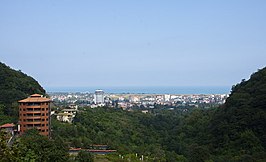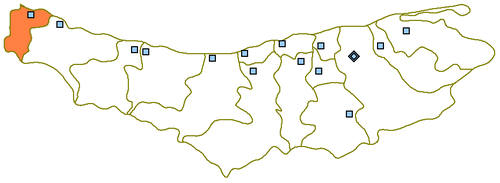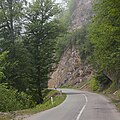| Ramsar Persian: رامسر | |
|---|---|
| City | |
     | |
| Motto: The Paradise on Earth (بهشت روی زمین) | |
  | |
| Coordinates: 36°55′21″N 50°38′35″E / 36.92250°N 50.64306°E / 36.92250; 50.64306 | |
| Country | Iran |
| Province | Mazandaran |
| County | Ramsar |
| District | Central |
| Government | |
| • Mayor (Ŝahrdār) | Ali Aminishad |
| Elevation | −21 m (−69 ft) |
| Population | |
| • Total | 35,997 |
| Time zone | UTC+3:30 (IRST) |
| Website | www |
Ramsar (Persian: رامسر) is a city in the Central District of Ramsar County, Mazandaran province, Iran, serving as capital of both the county and the district.
History
In 1971, Ramsar hosted the Ramsar Convention on Wetlands of International Importance, also known as the Convention on Wetlands. This international treaty for the conservation and sustainable use of designated wetlands (which under the treaty are known as Ramsar sites) was signed in and named after the city of Ramsar.
Overview
Ramsar lies on the Caspian Sea. It was also known as Sakhtsar in the past. The climate of Ramsar is hot and humid in summer and mild in winter. The proximity of the forest and the sea in this city attracts tourists in all seasons. Ramsar has an airport. The city of Ramsar was a small village in western Mazandaran until the Qajar period, and during the first Pahlavi period, with the rule of Reza Shah and with the support of the government, it became a city with many tourist facilities.
Ramsar is the westernmost county and city in Mazandaran. It borders the Caspian Sea to the north, Rudsar county of Gilan province to the west, Qazvin Province to the south, and Tonekabon to the east.

Demographics
Language and ethnicity
The Gilaks form the majority of the city's population. Their dialect of Gilaki is similar to that found in eastern Gilan and belongs to the Eastern or Bie-Pish branch.
Population
At the time of the 2006 National Census, the city's population was 31,659 in 9,241 households. The following census in 2011 counted 32,294 people in 10,432 households. The 2016 census measured the population of the city as 35,997 people in 12,153 households.
Geography
Climate
Ramsar has a humid subtropical climate (Köppen: Cfa, Trewartha: Cf), with warm, humid summers and cool, damp winters. Ramsar is the cloudiest city in Iran, as well as one of the cloudiest cities of this latitude, with annual sunshine of around 1582 hours. Northern Iran, as well as most portions of Iran, is separated by mountains. As a result, the air in Tehran is very dry. When driving to Ramsar from Tehran, one drives up the mountains until arriving at a tunnel. On passing through this tunnel and coming out the other side, the environment is very different; it is more humid and green due to moisture from the Caspian Sea, and this abundance of mist and rain is part of the attraction for tourists from the desert zones of Iran.
| Climate data for Ramsar (1955–2010, records 1955-2020) | |||||||||||||
|---|---|---|---|---|---|---|---|---|---|---|---|---|---|
| Month | Jan | Feb | Mar | Apr | May | Jun | Jul | Aug | Sep | Oct | Nov | Dec | Year |
| Record high °C (°F) | 31.0 (87.8) |
28.4 (83.1) |
36.8 (98.2) |
37.0 (98.6) |
34.4 (93.9) |
38.0 (100.4) |
35.6 (96.1) |
35.6 (96.1) |
35.2 (95.4) |
37.0 (98.6) |
32.0 (89.6) |
29.0 (84.2) |
38.0 (100.4) |
| Mean daily maximum °C (°F) | 10.9 (51.6) |
10.6 (51.1) |
11.9 (53.4) |
16.4 (61.5) |
21.4 (70.5) |
25.9 (78.6) |
28.6 (83.5) |
28.8 (83.8) |
25.8 (78.4) |
21.8 (71.2) |
17.3 (63.1) |
13.5 (56.3) |
19.4 (66.9) |
| Daily mean °C (°F) | 7.4 (45.3) |
7.3 (45.1) |
9.1 (48.4) |
13.3 (55.9) |
18.2 (64.8) |
22.6 (72.7) |
25.2 (77.4) |
25.4 (77.7) |
22.7 (72.9) |
18.4 (65.1) |
13.7 (56.7) |
9.8 (49.6) |
16.1 (61.0) |
| Mean daily minimum °C (°F) | 4.0 (39.2) |
4.1 (39.4) |
6.3 (43.3) |
10.1 (50.2) |
14.9 (58.8) |
19.2 (66.6) |
21.7 (71.1) |
22.0 (71.6) |
19.5 (67.1) |
15.1 (59.2) |
10.1 (50.2) |
6.1 (43.0) |
12.8 (55.0) |
| Record low °C (°F) | −10.0 (14.0) |
−6.0 (21.2) |
−3.0 (26.6) |
0.0 (32.0) |
5.0 (41.0) |
9.0 (48.2) |
10.8 (51.4) |
16.0 (60.8) |
10.0 (50.0) |
5.0 (41.0) |
−1.2 (29.8) |
−2.0 (28.4) |
−10.0 (14.0) |
| Average precipitation mm (inches) | 78.4 (3.09) |
73.5 (2.89) |
85.2 (3.35) |
53.3 (2.10) |
46.1 (1.81) |
57.9 (2.28) |
38.0 (1.50) |
65.4 (2.57) |
161.5 (6.36) |
260.2 (10.24) |
177.4 (6.98) |
109.3 (4.30) |
1,206.2 (47.47) |
| Average precipitation days (≥ 1.0 mm) | 9.0 | 8.7 | 11.0 | 8.3 | 7.3 | 4.9 | 3.9 | 6.6 | 8.6 | 11.6 | 9.2 | 8.8 | 97.9 |
| Average snowy days | 0.8 | 1.1 | 0.5 | 0.0 | 0.0 | 0.0 | 0.0 | 0.0 | 0.0 | 0.0 | 0.0 | 0.2 | 2.6 |
| Average relative humidity (%) | 84 | 85 | 87 | 86 | 84 | 81 | 79 | 81 | 84 | 85 | 84 | 84 | 84 |
| Average dew point °C (°F) | 4.9 (40.8) |
4.8 (40.6) |
7.1 (44.8) |
10.8 (51.4) |
15.8 (60.4) |
19.3 (66.7) |
21.4 (70.5) |
21.8 (71.2) |
19.7 (67.5) |
15.8 (60.4) |
10.5 (50.9) |
6.8 (44.2) |
13.2 (55.8) |
| Mean monthly sunshine hours | 105.6 | 97.1 | 92.7 | 119.7 | 165.5 | 189.6 | 188.9 | 168.7 | 126.1 | 119.1 | 111.1 | 98.2 | 1,582.3 |
| Source 1: IRIMO (records) | |||||||||||||
| Source 2: NOAA(dew point 1991-2020) | |||||||||||||
Radioactivity

Ramsar's Talesh Mahalleh district is the most radioactive inhabited area known on Earth, due to nearby hot springs and building materials originating from around them. A combined population of 2,000 residents from this district and other high radiation neighborhoods receive an average radiation dose of 10 mSv per year, ten times more than the ICRP-recommended limit for exposure to the public from artificial sources.
Record levels were found in a house where the effective radiation dose due to external radiation was 131 mSv/a, and the committed dose from radon was 72 mSv/a. This unique case is over 80 times higher than the world average background radiation.
One of the most commonly used models of radiation-induced cancer posits that the risk rises linearly with dose at a rate of 5% per Sv. If this linear no-threshold model is correct, it should be possible to observe an increased incidence of cancer in Ramsar through careful long-term studies currently underway. Early anecdotal evidence from local doctors and preliminary cytogenetic studies suggested that there may be no such harmful effect, and possibly even a radio-adaptive effect. More recent epidemiological data show a slightly reduced lung cancer rate and non-significantly elevated morbidity, but the small size of the population (only 1800 inhabitants in the highest-irradiated areas) will require a longer monitoring period to draw definitive conclusions.
Furthermore, there are questions regarding possible non-cancer effects of the radiation background. An Iranian study has shown that people in the area have a significantly higher expression of the CD69 gene and a higher incidence of stable and unstable chromosomal aberrations. Chromosomal aberrations have been found in other studies. Pending further study, the potential health risks had moved scientists in 2001–02 to call for relocation of the residents and regulatory control of new construction.
The radioactivity is due to the local geology. Underground water dissolves radium in uraniferous igneous rock and carries it to the surface through at least nine known hot springs. These are used as spas by locals and tourists. Some of the radium precipitates into travertine, a form of limestone, and the rest diffuses into the soil, where it is absorbed by crops and mixes with drinking water. Residents have unknowingly used the radioactive limestone as a building material for their homes. The stone irradiates the inhabitants and generates radon gas which typically promotes lung cancer. Crops contribute 72 μSv/yr to a critical group of 50 residents.
Environmental protection
The Convention on Wetlands, signed in Ramsar in 1971, is an intergovernmental treaty which provides the framework for national action and international cooperation for the conservation and wise use of wetlands and their resources. There are presently 160 contracting parties to the convention, with 1920 wetland sites, totaling 1,680,000 square kilometres (650,000 sq mi), designated for inclusion in the Ramsar List of Wetlands of International Importance. Presently, there are 160 contracting parties, up from 119 in 2000 and from 18 initial signatory nations in 1971. Signatories meet every three years as the Conference of the Contracting Parties (COP), the first held in Cagliari, Italy, in 1980. Amendments to the original convention have been agreed to in Paris (in 1982) and Regina, Canada (in 1987).
Tourism

Ramsar is a popular sea resort for Iranian tourists. The town also offers hot springs, the green forests of the Alborz Mountains, the vacation palace of the last Shah, and the Hotel Ramsar. Twenty-seven kilometres (17 mi) south of Ramsar and 2,700 metres (8,900 ft) above sea level in the Alborz mountains is Javaher Deh village, which is an important tourist attraction in Ramsar county. The road from Ramsar to Javaher Deh connects the city to Safarood forest park.
Twin towns and sister cities
Ramsar is twinned with:
 Puerto Montt, Chile (since 28 January 2009)
Puerto Montt, Chile (since 28 January 2009) Al Wakrah, Qatar (since 14 June 2010)
Al Wakrah, Qatar (since 14 June 2010) Shiraz, Iran (since 9 January 2013)
Shiraz, Iran (since 9 January 2013)
Notable people
- Mohammad Reza Khalatbari (b. 1983) - Football player
- Esfandiar Rahim Mashaei (b. 1960) - Politician
- Abbas Ali Khalatbari (1912–1979) - Iranian diplomat
- Hossein Khalatbari (1949-1985) - Iranian fighter pilot
- Elika Abdolrazzaghi (b. 1979) - Cinema, stage and TV actress
- Mohammad-Ali Taskhiri (1948-2020) - Iranian cleric and diplomat
- Hooman Khalatbari (b. 1969) - Music conductor
- Rahim Ebadi (b. 1957) - Politician
Gallery
-
The Old Hotel of Ramsar
-
The desk of Mohammad Reza Shah
-
 Dalikhani Forest
Dalikhani Forest
-
 Marble palace in Ramsar
Marble palace in Ramsar
-
 Ramsar Hotel
Ramsar Hotel
-
 Javaher Deh
Javaher Deh
-
 A walkway in front of the old hotel
A walkway in front of the old hotel
-
 Dalikhani Forest
Dalikhani Forest
-
 A palace in Ramsar
A palace in Ramsar
-
 Ramsar Caspian coast
Ramsar Caspian coast
-
Ramsar Bridge
-
 Ramsar Bazaar
Ramsar Bazaar
-
 Ramsar International Shopping
Ramsar International Shopping
-
 Ramsar Fish Market
Ramsar Fish Market
-
 Ramsar seaside
Ramsar seaside
See also
- Rejuvenation (aging)
- Background radiation
- Banana equivalent dose
- History of Iran
- Tourism in Iran
- International rankings of Iran
- Chalus
Notes
- Also romanized as Rámsar; also known as Ránsar; formerly Sakht Sar
References
- OpenStreetMap contributors (23 October 2024). "Ramsar, Ramsar County" (Map). OpenStreetMap (in Persian). Retrieved 23 October 2024.
- "بازارچه سنتی رامسر به زودی راهاندازی میشود". ایمنا. September 1, 2023.
- ^ Census of the Islamic Republic of Iran, 1395 (2016): Mazandaran Province. amar.org.ir (Report) (in Persian). The Statistical Center of Iran. Archived from the original (Excel) on 7 October 2021. Retrieved 19 December 2022.
- Ramsar, Iran can be found at GEOnet Names Server, at this link, by opening the Advanced Search box, entering "-3081959" in the "Unique Feature Id" form, and clicking on "Search Database".
- Habibi, Hassan (c. 2024) . Approval of the organization and chain of citizenship of the elements and units of the divisions of Mazandaran province, centered in Sari city. lamtakam.com (Report) (in Persian). Ministry of the Interior, Defense Political Commission of the Government Council. Subject Letter 3233.1.5.53; Notification 83346/T144K. Archived from the original on 14 January 2024. Retrieved 14 January 2024 – via Lam ta Kam.
- "The Ramsar Convention and its Mission". Archived from the original on 9 April 2016. Retrieved 11 October 2016.
- "Welcome to Encyclopaedia Iranica".
- "آموزش لهجه گیلکی رامسری(درس 10)".
- "تنکابن".
- Census of the Islamic Republic of Iran, 1385 (2006): Mazandaran Province. amar.org.ir (Report) (in Persian). The Statistical Center of Iran. Archived from the original (Excel) on 20 September 2011. Retrieved 25 September 2022.
- Census of the Islamic Republic of Iran, 1390 (2011): Mazandaran Province. irandataportal.syr.edu (Report) (in Persian). The Statistical Center of Iran. Archived from the original (Excel) on 19 January 2023. Retrieved 19 December 2022 – via Iran Data Portal, Syracuse University.
- "Iran's Caspian Coast – Memories From a 1984 Journey". Iran’s Caspian Coast – Memories From a 1984 Journey. Archived from the original on 2021-11-17. Retrieved 2021-11-15.
- "Ramsar Climate Normals 1955-2010". IRIMO. Retrieved April 7, 2015.
- "Highest record temperature in Ramsar by Month 1955–2010". Iran Meteorological Organization. Retrieved April 7, 2015.
- "Lowest record temperature in Ramsar by Month 1955–2010". Iran Meteorological Organization. Retrieved April 7, 2015.
- "WMO Climate Normals for 1991-2020: Ramsar" (CSV). ncei.noaa.gov. National Centers for Environmental Information. Retrieved 24 April 2024.
WMO number: 40732
- Selinus, Olle; Finkelman, Robert B.; Centeno, Jose A. (14 January 2011). Medical Geology: A Regional Synthesis. Springer. pp. 162–165. ISBN 978-90-481-3429-8. Retrieved 10 November 2012.
- ^ Mortazavi, S.M.J.; P.A. Karamb (2005). "Apparent lack of radiation susceptibility among residents of the high background radiation area in Ramsar, Iran: can we relax our standards?". Radioactivity in the Environment. 7: 1141–1147. doi:10.1016/S1569-4860(04)07140-2. ISBN 9780080441375. ISSN 1569-4860.
- Hendry, Jolyon H; Simon, Steven L; Wojcik, Andrzej; Sohrabi, Mehdi; Burkart, Werner; Cardis, Elisabeth; Laurier, Dominique; Tirmarche, Margot; Hayata, Isamu (1 June 2009). "Human exposure to high natural background radiation: what can it teach us about radiation risks?" (PDF). Journal of Radiological Protection. 29 (2A): A29 – A42. Bibcode:2009JRP....29...29H. doi:10.1088/0952-4746/29/2A/S03. PMC 4030667. PMID 19454802. Retrieved 1 December 2012.
- Gonzalez, Abel (February 1994). "Radiation Safety: New International Standards" (PDF). International Atomic Energy Agency.
- ^ Ghiassi-nejad, M; Mortazavi, SM; Cameron, JR; Niroomand-rad, A; Karam, PA (January 2002). "Very high background radiation areas of Ramsar, Iran: preliminary biological studies" (PDF). Health Physics. 82 (1): 87–93. doi:10.1097/00004032-200201000-00011. PMID 11769138. S2CID 26685238. Retrieved 11 November 2012.
- Mortazavi, S.M.J.; Ghiassi-Nejad, M.; Rezaiean, M. (2005). "Cancer risk due to exposure to high levels of natural radon in the inhabitants of Ramsar, Iran". High Levels of Natural Radiation and Radon Areas: Radiation Dose and Health Effects. 1276: 436–437. doi:10.1016/j.ics.2004.12.012.
- Mosavi-Jarrahi, Alireza; Mohagheghi, Mohammadali; Akiba, Suminori; Yazdizadeh, Bahareh; Motamedid, Nilofar; Shabestani Monfared, Ali (2005), "Mortality and morbidity from cancer in the population exposed to high level of natural radiation area in Ramsar, Iran", International Congress Series, 1276: 106–109, doi:10.1016/j.ics.2004.11.109
- Ghiassi-Nejad, M.; Zakeri, F.; Assaei, R.Gh.; Kariminia, A. (2004). "Long-term immune and cytogenetic effects of high level natural radiation on Ramsar inhabitants in Iran". J Environ Radioact. 74 (1–3): 107–16. doi:10.1016/j.jenvrad.2003.12.001. PMID 15063540.
- Zakeri, F.; Rajabpour, M. R.; Haeri, S. A.; Kanda, R.; Hayata, I.; Nakamura, S.; Sugahara, T.; Ahmadpour, M. J. (2011), "Chromosome aberrations in peripheral blood lymphocytes of individuals living in high background radiation areas of Ramsar, Iran", Radiation and Environmental Biophysics, 50 (4): 571–578, doi:10.1007/s00411-011-0381-x, PMID 21894441, S2CID 26006420
- Ghiassi-Nejad, M.; S. M. J. Mortazavi; M. Beitollahi; R. Assaie; A. Heidary; R. Varzegar; F. Zakeri; M. Jafari (2001). "Very High Background Radiation Areas (VHBRAs) of Ramsar: Do We Need Any Regulations to Protect the Inhabitants?". 34th Annual Midyear Meeting, "Radiation Safety and ALARA Considerations for the 21st Century", Regulatory Considerations Session. Anaheim, CA.
- Karam, P.A; Mortazavi, S.M.J; Ghiassi-Nejad, M; Ikushima, T; Cameron, J.R; Niroomand-rad, A (2002). "ICRP evolutionary recommendations and the reluctance of the members of the public to carry out remedial work against radon in some high-level natural radiation areas". Radiation and Homeostasis. 1236: 35–37. doi:10.1016/S0531-5131(01)00765-8.
- Ghiassi-Nejad, M; Beitollahi, MM; Asefi, M; Reza-Nejad, F (2003). "Exposure to (226)Ra from consumption of vegetables in the high level natural radiation area of Ramsar-Iran". Journal of Environmental Radioactivity. 66 (3): 215–25. doi:10.1016/S0265-931X(02)00108-X. PMID 12600755.
- "2011-03-07".
- "History of the Ramsar Convention | Ramsar". www.ramsar.org. Retrieved 2017-10-08.
- "Ramsar city in Mazandaran province". mazbus.com (in Persian). July 4, 2022. Retrieved July 5, 2023.
External links
- Ramsar's tourism
- Ramsar's radioactivity
- Photos of Ramsar (Permission to use and copy these photos is hereby granted provided the above copyright notice appears in all the copies and modified versions of photos.)
| Mazandaran province, Iran | |
|---|---|
| Capital | |
| Counties and cities | |
| Sights |
|
| populated places | |